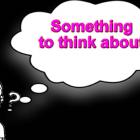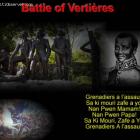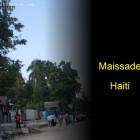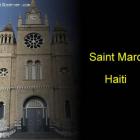ADVERTISEMENT
Voodoo - Haiti Observer Blog
Voodoo, Haiti Observer Blog. Read the following articles about Voodoo
Ganthier And Its Tourism Potential
If there is one place in Haiti where tourists may want to visit, it can be the town of Ganthier in the Arrondissement of Croix-des-Bouquets. The town has a lot of great stuff to offer to tourists. It is known for the production of Haiti arts such as crafts, handiworks and others. There is actually a tourist shop where people can buy souvenirs. Tourists are also fond of Ganthier's environs, as well as the l'étang Saumâtre located near by.
In addition to the regular tourists flocking the city are the pilgrims who arrive every year. Thousands of natives and pilgrims come to Ganthier to visit a holy site called the Calvaire Miracle. Most of the pilgrims are Catholic and Voodoo followers who pray and wish to get rid of their problems and start a new life. In order to signify the challenges and burden they carry, the pilgrims hold stones over their heads.
Plaine-du-Nord and Saint Jacques Fiesta
Haiti's Nord Department is in the northern most part of the country. It is where the small municipality of Plaine-du-Nord, often referred to as Plèn dinò in Creole, is located. It is considered an essential part of Haitian history and is one of the centres of the voodoo religion in the country.
Plaine-du-Nord is the historical site where the battle between Haiti's French colonizers and African slaves who worked in plantations began. This led to Haiti's independence from its colonizers and the freedom of slaves who became the very first official Haitians. The municipality is currently considered as the country's Pilgrimage Festival capital, which attracts thousands of worshippers and foreign visitors yearly. One of Plain-du-Nord's biggest, most important festivals is the Saint Jacques Fiesta, which is celebrated every 25th of July. It is then followed by the Saint Anne celebration a day after. Pilgrims usually stay for 15 days in the municipality during these festivities in order to offer food to the less fortunate, light candles, and donate money to the local churches.
Michel Martelly Visits Lakou Souvenance, Soukri Danach and Badjo
In the objective to support the Haitian Voodoo, Haitian President Michel Martelly visited three "Lakous" in the Artibonite Department on january 13, 2013: Lakou Souvenance, Lakou Soukri Danach, Lakou Badjo.
Martelly conducted the visits with an initiative coming from Culture Minister, Mario Dupuy. He entered inside of the Peristile of Souvenance with a Candle and a cup filled with water and and proceed to do the ritual called "Jete Dlow". The Haitian President received the benediction of the Haitian Voodoo priests or as they are called Houngan.
What is Souvenance?
Souvenance is one of lakous in the Artibonite region that are known for keeping a specific African Voodoo traditions. Lakou Souvenance celebrates the lwas originated from Daome which is called Benin today. Lakou Soukri Danach is known for celebrating the African Kongo tradition. Lakou Badjo has kept the Nago tradition of Yoruba.
Saut-d'Eau Waterfall, Ville Bonheur
Annually, during the summer months of Haiti, Voodoo believers make the trek from all over the country to the Saut-d'Eau waterfall in Ville Bonheur. There they feast and dance in a primitive expression of ecstasy, preparing themselves for a kind of baptism under Sant d'Eau waterfall's gushing stream.
This perennial event began in 1847 when witnesses described an apparition of the Virgin Mary appearing on a palm tree. Since then other Voodoo spirits of Iwa (one of the chief gods of Voodoo) have also manifested at the Saut-d'Eau waterfall.
The Voodoo religion was brought to Haiti by Congolese slaves, becoming embedded in Haiti's culture, early in its history. But the primary religion of faith in Haiti has always been the Catholic Church. The Voodoo religion has managed to survive, in part, because of its openness to outside influences. For this reason, Catholicism has helped to shape its religious rites. And the baptism at the Saut-d'Eau waterfall is an example of this influence.
Haitian President Francois Duvalier
The early years of independent politics in Haiti are marked by coup d'états and violence as several powerful political leaders clash for total control over the country. One of these notorious figures in this era of political turmoil is François Duvalier, more popularly known as "Papa Doc".
Francois Duvalier was Haiti's president for fourteen years from 1957 until his death in 1971. Before becoming the country's most powerful man, he was a physician in local hospitals and communities in the country where he treated the poor from infectious tropical diseases such as malaria and typhus. With his recollection of brutal political conflicts happening in Haiti during his time, Francois Duvalier was inspired to enter the world of politics. He was selected by then President Dumarsais Estimé as the National Public Health Service's Director General.
Legal Expert Says 2011 Constitution Does Not Endanger Voodoo Faith
An on-going debate over whether the practice of voodoo is being threatened by the amended 1987 Constitution has stirred the embers of its practitioners' fears.
Voodoo, brought to Haiti by Congolese slaves, became entrenched in Haitian culture, early in its history.
In 1935, under the rule of Stenio Vincent, the 1935 Decree Law defined voodoo as a superstitious belief system and banned the practice of it. For over 50 years, the Decree Law was not tampered with. By 1987, though, the amended Constitution struck down the Decree Law with Article 297, invalidating the definition of voodoo as a superstitious practice. A presidential decree on April 4, 2003, further legitimized the voodoo faith. But in May 2011, Article 297 was annulled, and has given rise to fears that voodooists would suffer persecution for their beliefs.
Haitian After Life Belief
In Haiti, religion is professed by almost all Haitians.
Religious demographics in Haiti are distributed as follows in the Haitian population: Roman Catholic 80%, Protestant 16% (Baptist 10%, Pentecostal 4%, Adventist 1%, other 1%), none 1%, other 3%.
Haitian Catholics, Baptists, Protestants and other Christians accept as true the existence of heaven, hell and purgatory; that the fate of the departed depends on how he lived his life on Earth. They believe in the teaching of the Catholic Church's teachings which holds that people who led a good life tend to go to Heaven, where they will be with God, angels, departed relatives, and fellow believers.
Haiti Zombie Culture an Outcome of Government Control
Zombies, like vampires, are dominating the entertainment media lately. You can view these monsters in movies, TV, and read of their ghoulish exploits in penny-ante novels. But contrary to the popular idea that zombies are evil incarnate, in Haitian lore they are victims of maltreatment at the hands of witch doctors known as bokers. The Haiti government has used the specter of these re-enlivened corpses to instill fear in the Haitian people, particularly during the Duvalier dynasty, which lasted nearly 30 years.
Papa Doc Duvalier formed a death-squad, the Tonton Macoutes, a group of men clad in denim shirts, straw hats, and sunglasses, who carried machetes. They often killed people in broad daylight, or carried them away in the dead of night, never to be seen or heard from again. The unexplained disappearance of a member of the Haitian community gave rise to the idea these victims had been turned into zombies, the living dead. Fed by Tonton Macoutes' threats they would zombie-fy anyone, whom they perceived as a dissident of the Duvalier regime, the legend took hold in Haitian imaginations.
The Celebration Of Haiti's Day Of The Dead
Haitians may not celebrate Halloween but they do have a holiday called Ghede. This is the day of the dead, when Haitians remember their deceased relatives and ancestors every November 2. Some Haitians describe Ghede as a New Year celebration for the dead because of the festivities and activities during the holiday.
Ghede is a huge part of the Vodun tradition, which calls for celebration and tribute to Ghede spirits. Baron Samedi is the God of Death and the leader of Ghede spirits, which are among the pantheon of Gods called as Loa. Haitians pay their respects to Baron Samedi, who they see as the wisest adviser, protector of children and the last hope of the sick.
Is there a connection between Halloween and Haitian Voodoo?
While Haitians do not exactly celebrate Halloween, they have their own version of the holiday. It is called the Haitian Voodoo, a tradition wherein tributes are paid to dead ancestors on November 1, which is referred to as Fete Gede. It is believed that voodoo god Baron Samedi, who is always depicted as a man donning a black coat, a bowler hat, and a pair of eyeglasses with only one lens, always appears on that day. His wife Gran Brigitte holds the highest authority over cemeteries in Haiti.
To commemorate the tradition, Haitians troop to cemeteries to pay their respects to the dead every November 1. It is common for them to bring food, flowers, and rum with chili peppers at the cemeteries. The next day, Haitians will then honor the Catholic saints.
Our objective is to share with you news and information about Haiti and the people of Haiti. Traditions, habits and the way we were or grew are alive in this site. We highly recommend that you Subscribe to our Newsletter and also share with us some of the things that are memorable and made us unique people.


 Something to think about
Something to think about  Battle of Vertieres
Battle of Vertieres  Haitians are a Proud People
Haitians are a Proud People  Maissade, Haiti
Maissade, Haiti  Saint Marc, Haiti
Saint Marc, Haiti